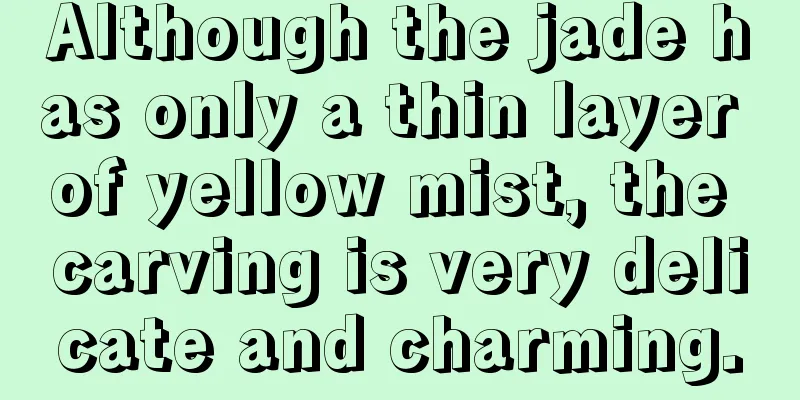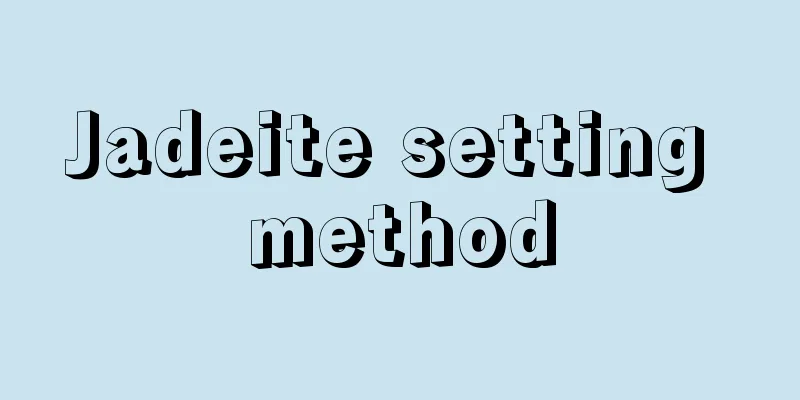Is jadeite valuable for collection?

|
Xinjiang's "Golden Silk Jade" is mainly produced in secondary deposits that are transported long distances by rivers. The "seed material" that has been naturally sorted has a fine and dense texture. After carving, it has a high ornamental and collection value. It is a unique variety in my country. Xinjiang Golden Silk Jade has all the noble qualities common to gemstones. Fine: fine texture, tight internal molecules, warm: the essence of jade, moist: like dew dripping, condensed: like transparent or semi-transparent frozen, greasy: like oil overflowing. So, is the carved jadeite Golden Silk Jade a jadeite worth collecting? Let's take a look today! The grade of "Xinjiang Golden Silk Jade" is evaluated based on the special requirements of the craft, with purity, transparency, color, texture, shape, and block size as the main conditions. Golden Silk Jade has rich colors, with yellow, red and white being the most common. The original stones are mostly three colors interlaced, with occasional blocks of gray, black, purple and other colors. This colorfulness gives the "clever color" craft more room to play. Golden silk jade is as soft as millet and wax, warm and delicate. This special texture allows skilled craftsmen to carve it at will and fully display their talents. Its rich colors inspire them to use colors for creation. The carved jadeite generally has a high collection value. Does carved jade have high collection value? That depends on its grade, which is generally based on purity, transparency, color, texture, shape, size, etc.; secondly, look at the "radish pattern." The "radish pattern" can be roughly divided into the following six types: The first is like the texture of the inner layer of radish skin. The "Silica Tian Huang" with a net-like texture and long eyes, which gradually becomes sparse from dense, is the most condensed and spiritual. The second type is shaped like rice dumplings. For example, when glutinous rice and alkali are steamed, the rice grains inside become melted. This radish pattern sometimes spreads out into strips. The third type is mesh. It is like a mesh, which is rounder than the first shape and is dispersed intermittently. The fourth type is like the pattern inside a radish, or imitating the pattern inside a winter melon, appearing as large irregular meshes, which may be light or dark, coarse or fine, or seem to penetrate from the surface of the stone. The fifth type is water flow pattern. The sixth type has basically no radish patterns, only a few sparse reticular patterns. This kind of "siliceous Tianhuang" is extremely rare and is one of the most condensed types of golden jade.
fcgc33 fcpf18 |
<<: Why is jade so valuable as a collection? You will understand after reading this
>>: Evaluation criteria for jadeite value
Recommend
The old blue water jadeite was sold for six figures. It is completely free of sand and has a fine texture. The effect of picking it up is very impressive!
Blue water jade is a relatively special type of j...
How much room for jade to maintain its value? Just understand these 4 points
In recent years, the price of jade has continued ...
Jade turns yellow after being worn for a long time. Does this mean that jade also has a shelf life?
We often say: Jade nourishes people, and people n...
The meaning and symbolism of jade
Today I will give you a brief introduction to the...
Afraid of being cheated when buying jade? First learn to distinguish between A, B, and C goods
First of all, B-grade and C-grade jade are relati...
If you don’t choose the right jade leaves, no matter how good the meaning is, it will be useless
When jade meets leaves, the Chinese people's ...
Jade has so many uses, no wonder it has been so popular since ancient times
There seems to be a jade trend sweeping the world...
alert! After dyeing and heating, this kind of high-grade red and yellow jadeite is not natural!
As we all know, yellow and red jade are secondary...
The production and processing of various jadeite, from jadeite raw stone to finished product
As we all know, although jade has a very high mar...
Jade turns yellow after being worn for a long time. Does this mean that jade also has a shelf life?
We often say: Jade nourishes people, and people n...
Extremely creative jade carving appreciation, you will really regret it if you don't see it
Chinese people often say that "Gold is easy ...
How to identify the authenticity of jade: If you use these 4 methods, you will be wrong
"Jade from the Ming and Qing Dynasties"...
Do you know the toughness of jade?
Toughness refers to the ability of an object to r...
How to identify the “forward and reverse grains” of jadeite?
The natural texture of jade is academically defin...
The color of jadeite changes a lot before and after polishing. I finally understand why I should buy old and fine jadeite.
People who have not been exposed to the jade proc...









